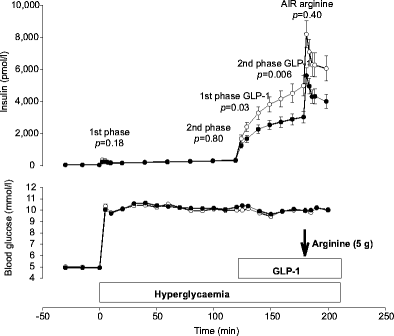Impaired glucagon-like peptide-1-induced insulin secretion in carriers of transcription factor 7-like 2 (TCF7L2) gene polymorphisms
- PMID: 17661009
- PMCID: PMC2063563
- DOI: 10.1007/s00125-007-0753-6
Impaired glucagon-like peptide-1-induced insulin secretion in carriers of transcription factor 7-like 2 (TCF7L2) gene polymorphisms
Erratum in
- Diabetologia. 2008 Jan;51(1):208. t' Hart, L M [corrected to 't Hart, L M]
- Diabetologia. 2009 Mar;52(3):557. Dosage error in article text
Abstract
Aims/hypothesis: Polymorphisms in the transcription factor 7-like 2 (TCF7L2) gene are associated with type 2 diabetes and reduced insulin secretion. The transcription factor TCF7L2 is an essential factor for glucagon-like peptide-1 (GLP-1) secretion from intestinal L cells. We studied whether a defect in the enteroinsular axis contributes to impaired insulin secretion in carriers of TCF7L2 polymorphisms.
Methods: We genotyped 1,110 non-diabetic German participants for five single nucleotide polymorphisms in TCF7L2. All participants underwent an OGTT; GLP-1 secretion was measured in 155 participants. In 210 participants, an IVGTT combined with a hyperinsulinaemic-euglycaemic clamp was performed. In another 160 participants from the Netherlands and 73 from Germany, a hyperglycaemic clamp (10 mmol/l) was performed. In 73 German participants this clamp was combined with a GLP-1 infusion and an arginine bolus.
Results: The OGTT data confirmed that variants in TCF7L2 are associated with reduced insulin secretion. In contrast, insulin secretion induced by an i.v. glucose challenge in the IVGTT and hyperglycaemic clamp was not different between the genotypes. GLP-1 concentrations during the OGTT were not influenced by the TCF7L2 variants. However, GLP-1-infusion combined with a hyperglycaemic clamp showed a significant reduction in GLP-1-induced insulin secretion in carriers of the risk allele in two variants (rs7903146, rs12255372, p < 0.02).
Conclusions/interpretation: Variants of TCF7L2 specifically impair GLP-1-induced insulin secretion. This seems to be rather the result of a functional defect in the GLP-1 signalling in beta cells than a reduction in GLP-1 secretion. This defect might explain the impaired insulin secretion in carriers of the risk alleles and confers the increased risk of type 2 diabetes.
Figures

Comment in
-
The enteroinsular axis may mediate the diabetogenic effects of TCF7L2 polymorphisms.Diabetologia. 2007 Dec;50(12):2413-6. doi: 10.1007/s00125-007-0832-8. Diabetologia. 2007. PMID: 17898988 No abstract available.
References
-
- {'text': '', 'ref_index': 1, 'ids': [{'type': 'DOI', 'value': '10.1038/ng1732', 'is_inner': False, 'url': 'https://doi.org/10.1038/ng1732'}, {'type': 'PubMed', 'value': '16415884', 'is_inner': True, 'url': 'https://pubmed.ncbi.nlm.nih.gov/16415884/'}]}
- Grant SF, Thorleifsson G, Reynisdottir et al (2006) Variant of transcription factor 7-like 2 (TCF7L2) gene confers risk of type 2 diabetes. Nat Genet 38:320–323 - PubMed
-
- {'text': '', 'ref_index': 1, 'ids': [{'type': 'DOI', 'value': '10.2337/diabetes.51.8.2341', 'is_inner': False, 'url': 'https://doi.org/10.2337/diabetes.51.8.2341'}, {'type': 'PubMed', 'value': '12145143', 'is_inner': True, 'url': 'https://pubmed.ncbi.nlm.nih.gov/12145143/'}]}
- Stumvoll M, Haring H (2002) The peroxisome proliferator-activated receptor-gamma2 Pro12Ala polymorphism. Diabetes 51:2341–2347 - PubMed
-
- {'text': '', 'ref_index': 1, 'ids': [{'type': 'DOI', 'value': '10.2337/diabetes.51.2007.S358', 'is_inner': False, 'url': 'https://doi.org/10.2337/diabetes.51.2007.s358'}, {'type': 'PubMed', 'value': '12475775', 'is_inner': True, 'url': 'https://pubmed.ncbi.nlm.nih.gov/12475775/'}]}
- Schwanstecher C, Schwanstecher M (2002) Nucleotide sensitivity of pancreatic ATP-sensitive potassium channels and type 2 diabetes. Diabetes 51(Suppl 3):S358–S362 - PubMed
-
- {'text': '', 'ref_index': 1, 'ids': [{'type': 'DOI', 'value': '10.1007/s00125-006-0502-2', 'is_inner': False, 'url': 'https://doi.org/10.1007/s00125-006-0502-2'}, {'type': 'PubMed', 'value': '17093941', 'is_inner': True, 'url': 'https://pubmed.ncbi.nlm.nih.gov/17093941/'}]}
- Chandak GR, Janipalli CS, Bhaskar et al (2006) Common variants in the TCF7L2 gene are strongly associated with type 2 diabetes mellitus in the Indian population. Diabetologia 50:63–67 - PubMed
-
- {'text': '', 'ref_index': 1, 'ids': [{'type': 'DOI', 'value': '10.1007/s00125-006-0477-z', 'is_inner': False, 'url': 'https://doi.org/10.1007/s00125-006-0477-z'}, {'type': 'PubMed', 'value': '17031610', 'is_inner': True, 'url': 'https://pubmed.ncbi.nlm.nih.gov/17031610/'}]}
- Vliet-Ostaptchouk JV, Shiri-Sverdlov R, Zhernakova et al (2006) Association of variants of transcription factor 7-like 2 (TCF7L2) with susceptibility to type 2 diabetes in the Dutch Breda cohort. Diabetologia 50:59–62 - PubMed
Publication types
MeSH terms
Substances
LinkOut - more resources
Full Text Sources
Other Literature Sources
Medical

